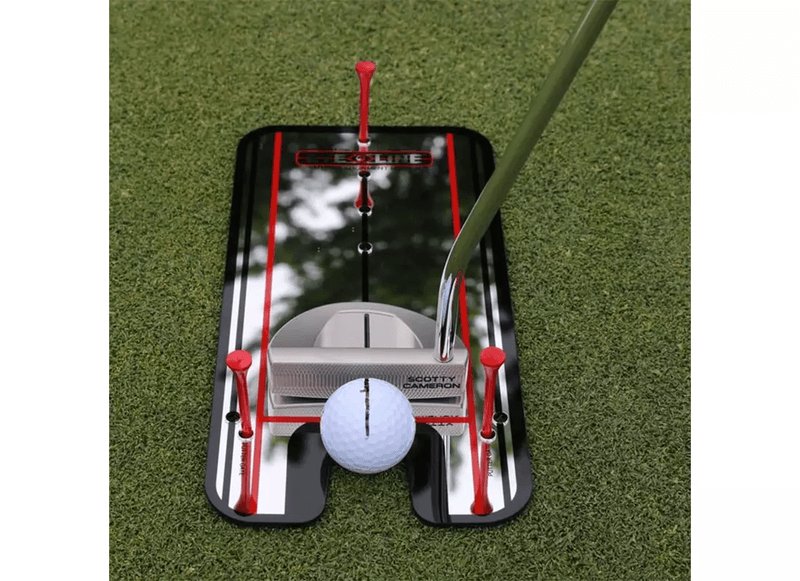Master the Art of Golf Putting: A Comprehensive Guide for Beginners
Posted by
This guide is designed to provide an in-depth look into the art of golf putting. From essential techniques every golfer must know, to understanding the biomechanics of a perfect golf putt, and exploring the top-rated training aids to maximize practice sessions. It is your one-stop-shop to master golf putting like a pro.

Understanding the Basics
What is Golf Putting?
Golf putting, often considered the game’s ultimate test of precision and patience, involves propelling the golf ball into the hole using a putter. Typically done on the putting green, the flattest and smoothest part of the golf course, golf putting requires a unique combination of technical skill, spatial awareness, and mental focus.
Decoding the Perfect Putt: Speed, Aim and Stroke
Creating the perfect putt involves a trifecta of speed, aim, and stroke. The speed at which you hit the ball is critical because it affects how far the ball will travel and how much it will be affected by the green’s slope and condition. The aim refers to your ability to accurately predict and target the ball’s direction, taking into account factors such as wind, slope, and the green’s condition. The stroke involves your putter’s movement, including your grip, swing, and follow-through.
3-Step Approach to Improve Your Golf Putting
Preparation: Reading the Green
One of the fundamental parts of becoming a skilled putter is learning how to read the greens accurately. This process involves understanding the shape, slope, and grain of the green to anticipate the path your ball will take after you hit it. Here are some popular methods of reading the green:
- Feet Feeling: This is a method that involves using your feet to feel the slope of the green while you walk around it. As you walk, pay attention to how your weight shifts – this can give you an idea of which way the green slopes.
- The Plumb Bob Method: This method involves using your putter as a plumb line to judge the slope. To do this, you need to stand behind your ball, at a right angle to the hole, and hold up your putter so it covers the ball. Then, you align the shaft of your putter with the ball. If the shaft seems to tilt to one side, it indicates that the green also slopes in that direction.
- Visual Inspection: Sometimes, the most straightforward method is the best. Stand behind the ball and look at the hole, then look at the ball from the hole’s side. This can often provide a good overall visual of the green’s undulations and slopes.
- The Book Method: Some golfers prefer using green-reading books, especially in professional tours. These books provide detailed illustrations of the green’s undulations and gradients, allowing the golfer to plan their putt more accurately.
- Using the Flagstick: If the flagstick is leaning towards or away from you, it can provide a clue about the green’s slope. But keep in mind, this is a more general guide and may not provide insight into the more subtle contours of the green.
- AimPoint Method: This technique, developed by Mark Sweeney, uses the golfer’s feet to feel the slope of the green and a hand-based system to express the slope’s steepness. Here’s a brief overview of how it works:
– Stand over your putt and feel the slope with your feet. Try to estimate the angle of slope – is it a 1%, 2%, or 3% slope?
– Stand behind your ball, facing the hole. Extend your arm out in front of you and raise a number of fingers corresponding to the slope percentage. Your fingers should be held vertically.
– The point at which your fingers intersect with the hole gives you an ‘AimPoint’. This is where you should aim your putt, rather than aiming directly for the hole.
It is a method that requires some practice, but many golfers find it to be very accurate once they get the hang of it. AimPoint classes are offered in many places and can help you master this method faster. Just like other methods, AimPoint becomes more effective when combined with a keen sense of observation and experience on the green.
Execution: Taking the Perfect Stroke
The execution of your stroke is crucial in golf putting. It’s a precise balance of form, rhythm, and contact, which, when all align, results in the perfect putt.
- Maintain a steady posture: Start by setting up a balanced and comfortable stance. Your feet should be shoulder-width apart, parallel to your target line. Lean forward from your hips so that your eyes are directly over or just inside the ball. This position allows you to swing the putter back and through along the target line.
- Align your shot: This step is often where many golfers go astray. Proper alignment is not just your body and the putter face aiming at the target. It is also about aligning your mind’s eye to the path you want the ball to take, all the way to the hole. Visualize this line, and when you’re setting up, point the putter face directly along this imagined line.
- Grip the putter comfortably: Your grip should be comfortable yet firm. The V’s formed by your thumb and forefinger of each hand should point to your right shoulder (for right-handed golfers). This grip style allows for greater control and less wrist action, which can often throw off a putt.
- Controlled Stroke: Keep your hands and wrists passive during the stroke. The motion should come from your shoulders, like a pendulum. Your backswing should be slow and controlled, then smoothly transition into the downswing, striking the ball and following through along the target line. Avoid abruptly stopping your putter after impact.
- Focus on the ball: From the moment you address the ball until it’s sent rolling along your chosen line, keep your eyes fixed on the ball. Avoid the urge to look up too quickly to see where the ball is going – this is a common mistake that can cause your body to move and potentially disrupt your stroke.
- Clean contact: Aim to hit the ball at its center with the sweet spot of the putter. This will send the ball rolling smoothly along the ground with minimal bounce or deviation from your intended line.
Post-Put Analysis: Learning from Your Putts
Analyzing your putt after its execution, whether it was successful or not, provides you with valuable feedback. Here are some key areas to focus on:
- Path of the Ball: Begin by assessing the initial line the ball took after you struck it. Did it start along the line you envisioned? If not, consider why this might have happened. Maybe your alignment was off, or perhaps the stroke deviated from the target line during the putt.
- Reading the Green: Now, consider the path your ball took after the initial roll. Did it behave as you expected based on your reading of the green? If the ball veered off course, you might need to refine your green-reading skills. Pay attention to how the ball moved, especially its speed and curve, as these will give you clues about the green’s characteristics.
- Stroke Evaluation: Consider the fluidity and control of your stroke. Did the putt feel forced or strained? Or did it feel natural and smooth? Evaluate your backswing and follow-through for any inconsistencies or jerkiness.
- Distance Control: How well did you judge the distance? If your putt was too short or too long, you might need to work on your distance control. This often involves improving your feel for the putter and the strength of your stroke.
- Emotional Response: Finally, take note of your emotional response to each putt. It’s common to feel frustrated after a miss or relieved after a make, but excessive emotional reactions can negatively impact your game. Strive to keep a calm and level-headed attitude, regardless of the result of each putt.
Drills and Exercises for Better Putts
Top 5 Drills to Improve Your Putts
Golf putting drills are designed to target specific aspects of your putting. These include the Gate Drill that improves your aim by making you putt between two objects; the Distance Control Drill that focuses on refining your speed control; the String Line Drill that helps enhance your stroke path; the Ladder Drill which helps you manage varying distances; and the Clock Drill that works on short putts from all angles.
Setting the Practice Regimen
Consistency is key to improving your golf putting. Determine how much time you can dedicate to practice each week and create a schedule. Incorporate a variety of drills to work on different aspects of your putting, dedicate time for reading the green, and also allocate time for analyzing your past putts. It’s about quality, not just quantity.
Choosing the Right Putter
Types of Putters
Putters come in two main types: blade putters and mallet putters. Blade putters are more traditional, have a simple design and are often favored by ‘feel’ putters who rely more on their intuition and touch. On the other hand, mallet putters have larger heads and offer more forgiveness on off-center hits, making them ideal for players who prefer a ‘straight-back-straight-through’ stroke.

Key Factors in Choosing Your Putter
When selecting a putter, consider the length, weight, balance point, loft, and aesthetics. Your height and the way you position yourself over the ball will influence the length of your putter. The weight affects your feel for the ball and how you control the putter, while the balance point influences your stroke path. The loft, or the angle of the putter’s face, affects how the ball comes off the putter.
Recommended Putter Brands
There are many excellent putter brands on the market. Renowned brands like Scotty Cameron, Odyssey, TaylorMade, and Ping are known for their superior quality and have been used by professional golfers worldwide.
Training Aids for Superior Performance
Putting Greens: The Indoor Solution
Indoor putting greens are the perfect solution for those who want to practice their putting skills but don’t always have the time to visit the golf course. These handy tools allow you to work on your putting at home, in the office, or anywhere you have a bit of free space.
They come in a variety of designs and sizes to suit different needs. You can find ones with simple, flat designs, and others with built-in slopes and hazards to better mimic the conditions on a real green. Some even offer different hole positions, allowing you to practice various putts without moving the green.
Popular brands such as SKLZ, Putt-A-Bout, and JEF World of Golf offer highly rated indoor putting greens that are worth considering. They provide high-quality, realistic surfaces that simulate the feel of a real green, and they’re built to last, ensuring that you can practice your putting for years to come.
Using an indoor putting green is a great way to improve your golf game without leaving your house. And with some dedicated practice, you’ll see improvements in your putting skills. For additional tips on how to maximize your practice in limited spaces, you can learn more about mastering chipping and putting in small spaces.
Training Mirrors: The Key to Perfect Alignment
Training mirrors are a fantastic tool to perfect your alignment, position, and stroke. They provide instant feedback, allowing you to correct issues in real-time. There are various types available, with Eyeline Golf’s Putting Alignment Mirror being a popular choice among both beginners and professionals.

Golf Balls for Practice: Are They Any Good?
Practice golf balls, especially those marked as ‘putting balls,’ can provide an economical and practical way to enhance your putting. They often have alignment lines to help with aiming and feedback on spin and roll to assist with stroke improvement.
Handling Slopes and Breaks
Have you ever found yourself standing on a golf green that’s full of slopes and breaks, unsure of how to navigate the tricky terrain? Well, you’re not alone. This can be one of the most challenging aspects of golf, but don’t worry—we’ve got some tips and techniques to help you take it in stride.
Reading the Green – Again
The key to dealing with slopes and breaks starts with reading the green correctly. It’s like reading a book—once you understand the story it’s telling, you’ll know how to respond. Look at the overall slope of the green, the grain of the grass, and how the green’s surroundings may influence the path of the ball.
Now, you might be wondering, “Is there a method to this madness?” Yes, indeed there is. There are several popular methods to decipher the green’s story, and AimPoint, as we mentioned earlier, is one of them.
AimPoint: Your Putting Compass
To use AimPoint, golfers typically extend their arm and use their fingers to indicate the slope’s direction and intensity. This allows them to visualize the optimal path for their putt, which greatly improves their chance of sinking it.
In fact, numerous top players, like Adam Scott and Stacy Lewis, swear by it. And you know what? With practice, you too can learn to use AimPoint to navigate those tricky greens. So, the next time you’re faced with a green that looks more like a roller coaster than a putting surface, remember—read, AimPoint, and putt!
Overcoming Challenges: Techniques for Sloping Greens
Sloping greens can be your worst nightmare or your best friend, depending on how well you know to handle them. Some golfers prefer a more direct approach—aiming straight for the hole, regardless of the slope. Others prefer to use the slope to their advantage, aiming off to the side and letting gravity do the rest.
Whatever your strategy, remember to always stay patient and focused. After all, Rome wasn’t built in a day, and mastering slopes and breaks won’t happen overnight. But with perseverance and practice, you’ll be sinking putts on sloping greens in no time!
Improving Golf Putting Through Imagery and Mental Practice
The Power of Positive Imagery
Imagery or visualization involves creating a mental image of your desired outcome. It’s about seeing the ball’s ideal path to the hole, imagining the perfect stroke, and visualizing the ball dropping into the hole. Positive imagery can reinforce good habits, boost confidence, and alleviate stress.
Visualization: A Key to Mastery of Putting
Visualization involves imagining the entire process of a putt, from the initial setup and stroke to the ball’s path and its final destination. Regular practice of visualization can improve focus, reinforce good habits, and promote a positive mindset.
Tips from the Pros
So, you’ve made it this far into your golfing journey. You’re beginning to understand the game’s intricacies, and you’re certainly becoming a friend of the green. Now, let’s take a moment to hear from those who’ve walked this path before us—the professional golfers who have perfected their putts through countless hours of practice and unyielding dedication. They’ve got a treasure trove of insights to share, and we’re all ears!
Stepping into Brad Faxon’s Shoes
Ever heard of Brad Faxon? If you haven’t, it’s high time you did. He’s famed in the golf world for his magical touch on the greens. His putting skills are the stuff of legend, and guess what? He’s more than willing to share his secrets!
One thing Faxon swears by is confidence—believing in your stroke and focusing on speed rather than the line to sink those putts. It’s like making a pancake, you know? You can have the best batter in the world, but if the pan’s too hot or too cold, you’re not getting that golden brown flapjack you crave. It’s all about finding the right speed.
And then there’s his rhythm, as smooth as a well-conducted symphony. Want to dig deeper into his strategies? Swing by this article which details the specific techniques Brad Faxon uses to improve his putting stroke.
Taking a Page from the Pros’ Playbook
You know, there’s something that all the top players have in common, aside from a shiny collection of trophies. They’ve all developed unique insights and techniques, fine-tuned over years of playing. From having solid pre-shot routines to maintaining perfect posture and alignment, they know the game inside and out.
And let’s not forget—the mental game is just as important as the physical one. Imagine you’re trying to thread a needle. You’ve got to have a steady hand, sure, but you also need the focus and patience to keep trying until you get it right. It’s the same with putting.
If you’re hungry for more of these expert tips, we’ve got you covered. Check out these 10 essential tips from the pros. Each one is a gem that can help you sharpen your skills and bring you one step closer to that perfect putt. Remember, every pro was once a beginner. Keep practicing, keep learning, and who knows? You might just become the next putting legend!
Putting Games to Enhance Your Skills
Introduction to BattlePutt
BattlePutt is a fun and competitive putting game that can be played with two or more players. It involves creating various challenges or ‘battles’ like longest putt, most consecutive putts, putting through obstacles, etc., making practice more engaging and stimulating.
Making Practice Fun with Miniature Golf Putting Courses
Miniature golf putting courses or ‘putt-putt’ golf provides a fun and relaxed setting to practice your putting skills. They feature various obstacles and slopes that can help improve your aim, control, and adaptability.
Common Golf Putting Mistakes and How to Avoid Them
Mistake 1: Poor Alignment
Poor alignment can lead to missed putts. Ensure that your feet, hips, and shoulders are aligned parallel to the target line. Using a training mirror or alignment sticks can help correct alignment issues.
Mistake 2: Incorrect Grip
An incorrect grip can cause lack of control and inconsistent putts. Your grip should be comfortable yet firm, allowing a smooth stroke. There are various types of grips like the reverse overlap, cross-handed, and the claw, and choosing the right one depends on what feels most natural and effective for you.
Mistake 3: Failing to Read the Green Correctly
Misreading the green can drastically affect your putt’s outcome. Spend time analyzing the green’s slope, grain, and condition before your putt. Consider factors like wind and moisture that can alter the ball’s path.
Maintaining Proper Form and Posture
The Ideal Putting Posture
The ideal putting posture involves bending from your hips, allowing your arms to hang naturally, and positioning your eyes over the ball. Your knees should be slightly flexed, and your weight should be balanced evenly on the balls of your feet. This posture enables a smooth, pendulum-like stroke.
Drills to Maintain Good Form
Drills like the Mirror Drill, where you practice your stroke while watching your form in a mirror, and the Gate Drill, where you swing your putter between two objects to ensure a straight stroke, can help maintain good form. Regularly performing these drills can promote muscle memory of the correct form.
Golf Putting FAQs
How Can Golf Putting Be Improved?
Golf putting can be improved through regular practice, using targeted drills, maintaining proper form, reading the green effectively, choosing the right putter, and employing mental strategies like positive imagery and visualization. Analyzing and learning from each putt is also crucial for improvement.
How to Learn Golf Putting?
Learning golf putting involves understanding the basics, practicing regularly, studying professional golfers’ techniques, and getting hands-on experience on the course. It’s also beneficial to get guidance from a professional golf coach and use tools like putting aids and instructional books or videos.
How to Choose the Right Putter?
Choosing the right putter depends on your personal style and needs. Consider factors like the putter’s length, weight, balance, loft, and type (blade or mallet). Try out various putters to see what feels best for you, and don’t hesitate to seek professional advice if needed.
What is the importance of the pre-putt routine?
A consistent pre-putt routine helps to instill confidence and reduces the impact of nerves or pressure. This routine may involve reading the green, aligning your shot, taking a few practice strokes, and visualizing the ball’s path into the hole. Developing and adhering to your own pre-putt routine can enhance your putting performance.
Is there an ideal putting grip?
There isn’t a universally ideal grip for putting as it largely depends on what feels comfortable and provides the best control for the individual golfer. However, some popular putting grips include the reverse overlap, the cross-handed or left-hand-low, the claw, and the arm lock. Experiment with different grips to find the one that works best for you.
How much time should I spend practicing putting?
The exact amount of time can vary based on individual goals and skill level. However, a commonly suggested guideline is to dedicate about half of your practice time to putting since it accounts for approximately 40-50% of strokes in a round of golf. This could be around an hour if you practice golf for two hours, for instance. Regular, focused practice is key to improvement.
